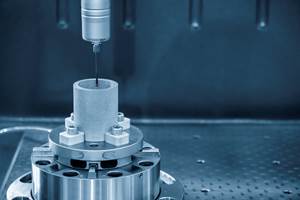In Hogout Machining, the CAD File Becomes Critical
To serve customers by helping them bypass casting, this shop first needs a close-enough relationship with the customer that it can count on getting good CAD data. Here is why.
Share






The January issue of 91ÊÓƵÍøÕ¾ÎÛ describes R&D Manco’s ongoing shift from machining castings to greater machining of hogouts. One significant detail the article did not have the chance to address is the growing significance this shift brings to having complete and precise CAD data from the customer. In short, before R&D Manco could help its customers by streamlining its manufacturing, it first had to have conversations with customers about obtaining these reliable digital models.
Five-axis machining is part of the reason. Machining castings need not be as complex as machining from solid. The machining of castings is liable to include milling mating surfaces and drilling and tapping holes. This machining might be multi-face or multi-setup, but not five-axis. By contrast, programming the five-axis contour-machining cycle for a part with the organic, complex form of a casting obviously requires an accurate part model from the customer. In hogout machining, the digital model rather than the physical casting is the shop’s starting point.
The digital model is also the end point because it is this model that defines what the customer expects and what the shop will deliver. Indeed, having a good CAD model offers the chance to not only streamline machining (applying tactics such as trochoidal machining, for example, where the stock allowance around the parts permits), but also streamline inspection. R&D Manco recently began experimenting with “Productivity+” software from Renishaw, software for comparing probing measurements of a machined part at the machine tool with the original CAD model for that part. So far, the shop has developed enough confidence in this software to trust it for first-article inspection, an advance that saves considerable time. The part no longer has to be removed from the machine tool while the machine and the machinist wait for first-article inspection as an independent step, but instead, this validation of the machining process now can be quickly performed entirely at—and by—the machine tool.
But another vital opportunity the CAD model provides in hogout machining is the chance to save the customer money by proposing geometric changes. A part that was formerly a casting frequently has features only a casting requires. Examples include radiused features that are natural to casting but would demand a significant amount of cycle time for contour milling if they had to be reproduced in machining. Frequently, a part converted from casting to hogout is so well established that no one involved has any memory that certain features were designed for casting’s sake alone. Part of the job of CAM programmers at R&D Manco, therefore, is to spot and question potentially unnecessary features such as this.
Indeed, with the advance into greater machining of hogouts, the role of the CAM programmer at this shop and demand on programming capacity have significantly expanded. In the past, this shop had two engineers proficient at CAM programming, and that was plenty. Today, two other engineers who have previously been involved with process planning are also being trained in CAM programming, so the number of programmers will soon be four.
Related Content
Parts and Programs: Setup for Success
Tips for program and work setups that can simplify adjustments and troubleshooting.
Read More6 Machine Shop Essentials to Stay Competitive
If you want to streamline production and be competitive in the industry, you will need far more than a standard three-axis CNC mill or two-axis CNC lathe and a few measuring tools.
Read MoreHow to Choose the Correct Fixed-Body Plug Gaging Solution
The two types of fixed-body plug gages are both accurate, fast and easy to use. Consider these factors when selecting one for your gaging application.
Read MoreHow to Evaluate Measurement Uncertainty
Manufacturing and measurement are closely coupled. An important consideration for the use of measurement results is the associated measurement uncertainty. This article describes common metrology terms and provides an example uncertainty analysis.
Read MoreRead Next
Machine Shop MBA
Making Chips and 91ÊÓƵÍøÕ¾ÎÛ are teaming up for a new podcast series called Machine Shop MBA—designed to help manufacturers measure their success against the industry’s best. Through the lens of the Top Shops benchmarking program, the series explores the KPIs that set high-performing shops apart, from machine utilization and first-pass yield to employee engagement and revenue per employee.
Read MoreLast Chance! 2025 Top Shops Benchmarking Survey Still Open Through April 30
Don’t miss out! 91ÊÓƵÍøÕ¾ÎÛ's Top Shops Benchmarking Survey is still open — but not for long. This is your last chance to a receive free, customized benchmarking report that includes actionable feedback across several shopfloor and business metrics.
Read MoreAMRs Are Moving Into Manufacturing: 4 Considerations for Implementation
AMRs can provide a flexible, easy-to-use automation platform so long as manufacturers choose a suitable task and prepare their facilities.
Read More





















